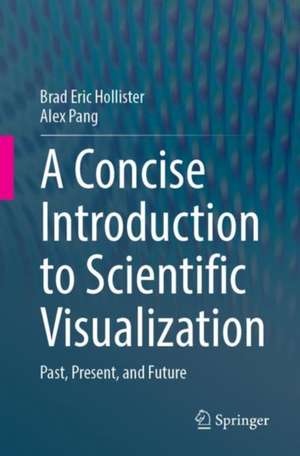A Concise Introduction to Scientific Visualization: Past, Present, and Future
Autor Brad Eric Hollister, Alex Pangen Limba Engleză Paperback – 2 ian 2022
A Concise Introduction to Scientific Visualization – Past, Present, and Future serves as a primer to visualization without assuming prior knowledge. It discusses both the history of visualization in scientific endeavour, and how scientific visualization is currently shaping the progress of science as a multi-disciplinary domain.
Preț: 194.04 lei
Preț vechi: 242.55 lei
-20% Nou
Puncte Express: 291
Preț estimativ în valută:
37.15€ • 38.76$ • 31.14£
37.15€ • 38.76$ • 31.14£
Carte tipărită la comandă
Livrare economică 13-27 martie
Preluare comenzi: 021 569.72.76
Specificații
ISBN-13: 9783030864187
ISBN-10: 3030864189
Pagini: 107
Ilustrații: VII, 107 p. 82 illus., 61 illus. in color.
Dimensiuni: 155 x 235 mm
Greutate: 0.17 kg
Ediția:1st ed. 2022
Editura: Springer International Publishing
Colecția Springer
Locul publicării:Cham, Switzerland
ISBN-10: 3030864189
Pagini: 107
Ilustrații: VII, 107 p. 82 illus., 61 illus. in color.
Dimensiuni: 155 x 235 mm
Greutate: 0.17 kg
Ediția:1st ed. 2022
Editura: Springer International Publishing
Colecția Springer
Locul publicării:Cham, Switzerland
Cuprins
Preface.- Early Visual Models.- Illustration and Analysis.- Scientific Visualization in the 19th Century.- A Convergence with Computer Science.- Recent Developments.- The Future.- Bibliography
Notă biografică
Brad E. Hollister holds a PhD from the University of California Santa Cruz in Computer Science and worked as a postdoctoral researcher at the University of Utah’s Scientific Computing and Imaging Institute. He is the author of "Core Blender Development,” published by Apress. Dr. Hollister is also faculty adviser for the Open-Source Mozilla Campus Club at the California State University Dominguez Hills. His research includes scientific visualization and virtual reality for training.
Alex Pang is a Professor of Computer Science and Engineering at the University of California, Santa Cruz. He received his PhD in Computer Science from UCLA and his BS in Industrial Engineering from University of the Philippines. His research interests are in comparative and uncertainty visualization, flow and tensor visualization, and collaborative visualization. Professor Pang has received a certificate of recognition for previous NASA work, as well as an excellence in teaching award from UCSC. He has previously served as an associate editor of the IEEE Transactions on Visualization and Computer Graphics and was papers co-chair for the IEEE Visualization conference
Textul de pe ultima copertă
Scientific visualization has always been an integral part of discovery, starting first with simplified drawings of the pre-Enlightenment and progressing to present day. Mathematical formalism often supersedes visual methods, but their use is at the core of the mental process. As historical examples, a spatial description of flow led to electromagnetic theory, and without visualization of crystals, structural chemistry would not exist. With the advent of computer graphics technology, visualization has become a driving force in modern computing. A Concise Introduction to Scientific Visualization – Past, Present, and Future serves as a primer to visualization without assuming prior knowledge. It discusses both the history of visualization in scientific endeavour, and how scientific visualization is currently shaping the progress of science as a multi-disciplinary domain.
Caracteristici
Provides a contextual overview of scientific visualization from a historical perspective Serves as an intuitive guide for those with less technical backgrounds Includes many visual examples to illustrate concepts
